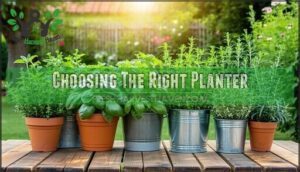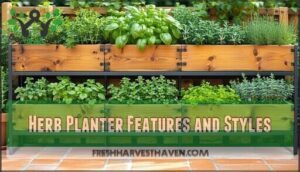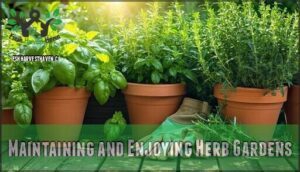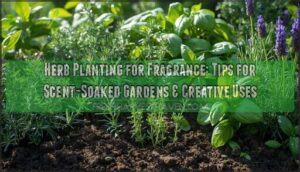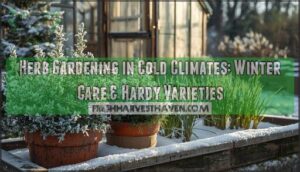This site is supported by our readers. We may earn a commission, at no cost to you, if you purchase through links.
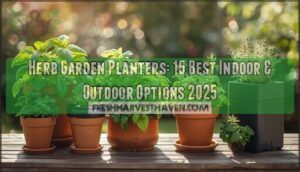
You’ll find options ranging from sleek hydroponic systems that practically grow themselves to classic terracotta pots that bring rustic charm to your space.
The best herb garden planters feature proper drainage, adequate root space, and durable materials that withstand your local climate.
Indoor models often include self-watering systems and LED grow lights, while outdoor versions focus on weather resistance and mobility.
Popular herbs like basil, mint, and rosemary thrive in most planters with minimal fuss, and smart features and stackable designs maximize your growing potential.
Table Of Contents
- Key Takeaways
- Benefits of Herb Gardens
- Choosing The Right Planter
- Top 15 Herb Garden Planters
- 1. Aerogarden Harvest Elite Indoor Hydroponic Garden
- 2. Stackable Vertical Garden Planter Tiered Oasis
- 3. Click Grow Smart Garden Indoor Herb Kit
- 4. Inbloom Hydroponics Growing System Indoor Garden Kit
- 5. iDOO 12 Pod Hydroponics Growing System
- 6. Veritable Smart Garden Artic White
- 7. ingarden Microgreens Kit Organic Superfood Mint
- 8. White Metal Herb Garden Planter Set
- 9. VegTrug Herb Garden Raised Planter
- 10. Cole Mason Burwell Herb Keeper Triple
- 11. LEETOLLA 32 Inch Rolling Garden Bed
- 12. Mr Stacky 5 Tier Planter
- 13. Keter Urban Bloomer Raised Garden
- 14. VIVOSUN Self Watering Herb Planter Box
- 15. Herb Garden Planter Indoor Set
- Herb Planter Features and Styles
- Maintaining and Enjoying Herb Gardens
- Frequently Asked Questions (FAQs)
- What planters are best for herbs?
- What herbs not to plant together in pots?
- Do herbs like deep or shallow pots?
- What is the best layout for an herb garden?
- How do you create a successful herb garden planter?
- What are the best materials to use for an herb garden planter?
- Are herb garden planters suitable for outdoor use?
- What are some of the most popular herbs to grow in planters?
- What herbs go well together in a container?
- Do herbs need a deep planter?
- Conclusion
Key Takeaways
- You’ll save 70% on grocery costs by growing fresh herbs at home while enjoying superior flavor and nutrition compared to store-bought alternatives
- You need planters with proper drainage holes, 6-12 inch depth, and durable materials like cedar, stainless steel, or terra cotta to prevent root rot and ensure healthy growth
- Hydroponic systems like AeroGarden grow herbs 5x faster than soil, while vertical stackable planters maximize space by fitting 15-20 plants in one square foot
- You should group herbs by their water and light needs – Mediterranean varieties (rosemary, thyme) together in dry conditions, moisture-loving herbs (basil, parsley) separately, and keep mint isolated to prevent spreading
Benefits of Herb Gardens
Growing your own herb garden brings fresh flavors directly to your kitchen while saving money on expensive store-bought herbs.
You’ll enjoy healthier, more nutritious herbs picked at peak freshness, plus add beautiful greenery to your living space whether you’re gardening indoors or outdoors.
Fresh Herbs at Home
Nothing beats the convenience of snipping fresh basil from your indoor herb garden while dinner simmers.
Fresh herbs at your fingertips – transforming every meal into a culinary masterpiece.
You’ll discover herb flavor profiles that store-bought versions can’t match – homegrown oregano packs twice the punch of dried alternatives.
Kitchen herb garden planters let you harvest therapeutic herb properties year-round, transforming your culinary creations with vibrant, nutrient-dense fresh herbs that retain their essential oils.
Cost-Effective and Space-Saving
Herb garden planters slash grocery costs by up to 70% compared to store-bought herbs.
Small herb garden setups like windowsill herbs and hanging baskets maximize limited space effectively.
DIY planters and pallet gardens offer budget-friendly vertical solutions that transform unused areas into productive growing zones.
Vertical herb garden designs stack multiple plants upward, making space-saving solutions perfect for apartments and compact homes.
Consider proper soil drainage for healthy plants, which is a crucial aspect of herb gardening.
Improved Cooking and Ambiance
Fresh herbs constantly transform your culinary adventures, delivering unmatched flavor enhancement that store-bought alternatives simply can’t match.
Your kitchen herbs from herb garden planters provide aromatic benefits that fill your space with natural fragrance while boosting culinary creativity.
These homefresh ingredients elevate garden aesthetics, creating an inviting atmosphere that makes cooking more enjoyable and inspiring, with the natural fragrance of herbs being a key factor in this culinary creativity.
Choosing The Right Planter
Selecting the right planter for your herbs determines whether your garden thrives or struggles with poor drainage and cramped roots.
You’ll need to take into account material durability, proper drainage holes, adequate depth for root growth, and whether you’re growing indoors or outdoors, considering factors like proper drainage.
Material and Drainage Considerations
Material durability determines your planter’s lifespan and herb health.
Choose wisely between these drainage systems:
- Terracotta pots – Perfect for Mediterranean herbs needing dry roots like rosemary
- Plastic containers – Retain soil moisture longer, ideal for cilantro and parsley
- Cedar planters – Food-safe with natural drainage properties
Proper drainage holes prevent root rot while planter composition affects moisture retention for ideal growing conditions.
You can find various terracotta pot designs for your herbs.
Size and Capacity for Herb Roots
Different herbs need varying root space, so you’ll want to match planter depth and container volume to each herb’s growth habits.
Small herbs like thyme thrive in 6-inch containers, while larger herb varieties such as rosemary demand 12-inch depths for proper root growth.
Understanding these size capacity requirements guarantees your container herb garden flourishes with healthy, productive plants.
Indoor and Outdoor Placement Options
Consider your lifestyle when choosing between indoor herb garden and outdoor herb garden setups.
Indoor planters need proximity to windows for sunlight needs, while outdoor herb planter box options require weather resistance.
Space considerations matter—compact best herb planters work on windowsills, while larger indooroutdoor planters offer flexibility.
To avoid root rot, ensure proper drainage in your chosen containers.
Aesthetic preferences and portability options help you create the perfect herb sanctuary.
Top 15 Herb Garden Planters
You’ll find fifteen carefully selected herb planters that combine functionality with style to transform your growing experience.
These options range from high-tech hydroponic systems to classic raised beds, ensuring there’s a perfect match for your space and gardening preferences, with a focus on functionality.
1. Aerogarden Harvest Elite Indoor Hydroponic Garden
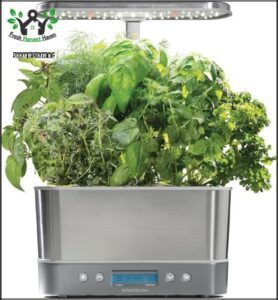
Among indoor hydroponic systems, you’ll find the AeroGarden Harvest Elite stands out for its compact design and impressive growing speed.
This stainless steel unit grows up to six herbs in just 10.5 inches of counter space, using a 20W LED light system that accelerates growth up to five times faster than soil.
The digital display reminds you when to add water and nutrients, while vacation mode keeps plants healthy when you’re away.
Setup takes under ten minutes with pre-seeded pods included, making it a quick and easy process to get started with your indoor hydroponic system.
Best For: Home cooks and apartment dwellers who want fresh herbs year-round without outdoor gardening space or soil mess.
- Grows plants up to 5x faster than soil with automated LED lighting and nutrient reminders
- Compact 10.5" x 6.25" footprint fits easily on kitchen counters with attractive stainless steel design
- Simple 10-minute setup with pre-seeded pods and vacation mode for hands-off maintenance
- Mixed germination success rates with some pre-seeded pods failing to sprout properly
- Limited to 6 plants with 12-inch height restriction, making it less suitable for larger vegetables
- Higher price point compared to off-brand alternatives and requires ongoing pod replacements
2. Stackable Vertical Garden Planter Tiered Oasis
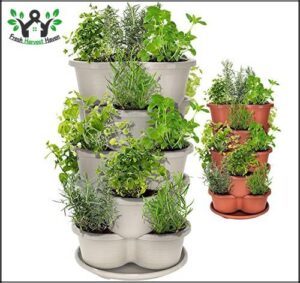
This space-saving champion fits 15 plants in under one square foot, making it perfect for cramped balconies or tiny kitchens.
You’ll love how the five-tier system lets you arrange herbs by their light needs—sun-worshippers on top, shade-lovers below.
Proper drainage is essential to prevent root rot.
The polypropylene construction withstands weather and won’t crack, though it can get top-heavy without proper soil filling.
Each tier drains into the next, creating a clever watering cascade that keeps your herbs happy without drowning them, ensuring proper drainage is maintained, and the system remains a space-saving champion with a five-tier system.
Best For: Apartment dwellers and small-space gardeners who want to grow 15 plants in minimal floor space while maintaining easy access for care and harvesting.
- Limited 5-inch pod size restricts growth of larger plant varieties and root systems
- Can become dangerously top-heavy if upper tiers aren’t properly filled with soil
- Central pole extends above top tier, creating a potential safety hazard for users
- Space-efficient vertical design fits 15 plants in under one square foot of floor space
- Intelligent drainage system cascades water from top to bottom tiers, preventing overwatering
- Durable polypropylene construction resists weather damage and won’t crack under normal use
3. Click Grow Smart Garden Indoor Herb Kit
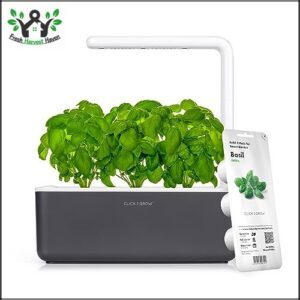
Smart gardening takes the guesswork out of growing herbs with Click & Grow’s innovative system.
You’ll get pesticide-free herbs 30-50% faster than traditional soil methods using their patented Smart Soil technology.
The self-watering design refills every few weeks, while LED lights provide ideal illumination year-round.
With over 50 pre-seeded pod varieties and foolproof setup, you can harvest fresh basil and other herbs within weeks, making it perfect for beginners.
Best For: Home cooks and beginners who want fresh, pesticide-free herbs year-round without the hassle of traditional gardening.
- Automated watering and LED lighting system requires minimal maintenance with refills every few weeks
- Smart Soil technology produces herbs 30-50% faster than traditional methods with optimal nutrients built-in
- Over 50 plant pod varieties available with foolproof setup that works reliably for beginners
- Limited to compact plants due to height restrictions from LED light placement
- Replacement pods are expensive despite germination guarantee coverage
- Fixed 16-hour light timer may be too bright for some living spaces with no manual override
4. Inbloom Hydroponics Growing System Indoor Garden Kit
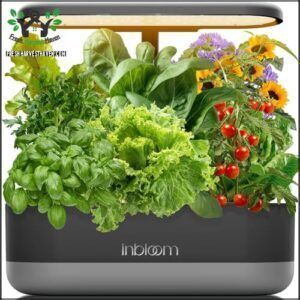
Twelve pods accommodate everything from basil to cherry tomatoes, giving you serious growing potential in one compact unit.
You’ll appreciate the 4.2L water tank that feeds your plants for up to 30 days, while LED grow lights provide 16 hours of ideal spectrum daily.
The system circulates water every 30 minutes, delivering nutrients directly to roots for growth that’s five times faster than soil.
With germination in three days and harvestable herbs in two weeks, you’ll wonder why you ever bothered with traditional gardening.
Best For: Home cooks, apartment dwellers, and gardening beginners who want fresh herbs and vegetables year-round without outdoor space or soil gardening experience.
- Achieves 5x faster growth than traditional soil gardening with germination in 3 days and harvestable herbs within 2 weeks
- Large 4.2L water tank sustains plants for 15-30 days between refills, with automated lighting and pump cycles for minimal maintenance
- Accommodates 12 pods supporting everything from herbs to larger vegetables like tomatoes and peppers in one compact countertop unit
- Water pump failures reported after 6 months of use with difficulty finding replacement parts
- Pump noise can be bothersome, especially when running multiple units
- Requires careful seed selection and spacing to prevent overcrowding in the 12-pod system
5. iDOO 12 Pod Hydroponics Growing System
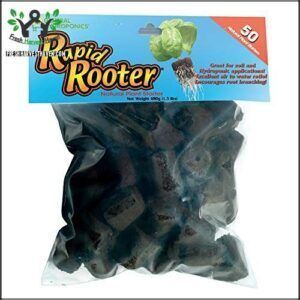
When you’re ready to grow herbs year-round, this 12-pod hydroponic system delivers consistent results.
You’ll appreciate its 23-24 watt full-spectrum LED light that adjusts up to 15.75 inches, perfect for herbs at different growth stages.
The built-in fan and water pump work on 30-minute intervals to keep your plants healthy, with three smart lighting modes and auto cycles running 12-16 hours daily, your herbs grow 20% faster than soil-based gardens.
The 4-liter water tank means less frequent refilling, while water shortage alerts prevent pump damage, ensuring a healthy environment for your plants.
Best For: Beginner gardeners and herb enthusiasts who want fresh kitchen herbs year-round without outdoor garden space or soil mess.
- Limited depth restricts larger fruiting plants like tomatoes, requiring eventual transplanting
- Requires regular maintenance with water changes every 2-4 weeks and nutrient replenishment
- Base models lack Wi-Fi or app control features found in premium hydroponic systems
- Grows plants 20% faster than soil with full-spectrum LED light and hydroponic circulation system
- Simple setup with 4-liter water tank requiring refills only every 2-3 weeks and water shortage alerts
- Compact countertop design (8×10.5 inches) fits small spaces while supporting 12 plants simultaneously
6. Veritable Smart Garden Artic White

When you’re ready to transform your indoor growing game, the Veritable Smart Garden Arctic White delivers restaurant-quality herbs without the guesswork.
This French-engineered system uses patented Lingots (ready-to-grow pods) that contain everything your plants need—organic seeds, nutrients, and substrate—for foolproof cultivation.
You’ll enjoy automated LED lighting that mimics natural daylight cycles, plus sub-irrigation that waters your herbs for up to four weeks.
The sleek Arctic White design fits perfectly on countertops while supporting over 70 plant varieties that grow three times faster than traditional methods.
Best For: Urban dwellers and busy households who want fresh herbs year-round without gardening experience or outdoor space.
- Fully automated system handles lighting cycles and watering for up to 4 weeks with minimal maintenance
- Grows over 70 plant varieties up to 3 times faster than traditional methods using patented Lingots system
- Compact Arctic White design fits on countertops while providing restaurant-quality herbs consistently
- Lingot availability can be inconsistent in the US, limiting long-term usability
- Mixed success rates with some herbs like chives and thyme failing to sprout or developing mold
- Customer support has been criticized for slow response times when addressing product issues
7. ingarden Microgreens Kit Organic Superfood Mint
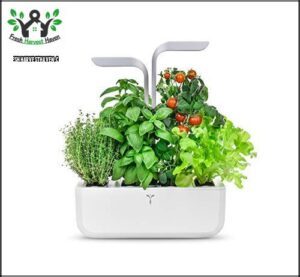
Focusing specifically on microgreens rather than traditional herbs, this compact hydroponic system delivers impressive nutritional benefits in your kitchen.
You’ll harvest microgreens packed with up to 40 times more nutrients than mature vegetables, supporting your health with antioxidants, vitamins, and essential minerals.
The sleek Scandinavian design fits seamlessly into any space while using 90% less water than soil-based growing.
With biodegradable seed pads and automatic LED lighting, you’ll see sprouts in three days and enjoy fresh harvests weekly with minimal effort required.
Best For: Urban gardeners and health-conscious individuals seeking fresh, nutrient-dense microgreens year-round without soil mess or extensive gardening knowledge.
- Limited to microgreens only, unlike systems that can grow full-sized herbs and vegetables for greater variety
- Requires ongoing purchase of proprietary seed pads, creating recurring costs that may add up over time
- Mild flavor profile of microgreens may not satisfy users seeking bold herb flavors for cooking applications
- Produces microgreens with up to 40 times more nutrients than mature vegetables, delivering exceptional health benefits in a compact system
- Uses 90% less water than traditional gardening while providing weekly harvests with minimal maintenance required
- Sleek Scandinavian design fits any kitchen space and features biodegradable seed pads with automatic LED lighting for effortless growing
8. White Metal Herb Garden Planter Set
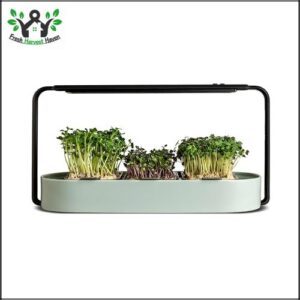
Choose this white metal planter set when you want clean aesthetics without sacrificing functionality.
The three 4.3-inch pots with drainage holes nest perfectly on a 12.5-inch tray, making them ideal for windowsill herb gardens.
You’ll appreciate the galvanized steel construction that resists rust for up to 15 years while reflecting heat to protect roots.
The lightweight design lets you move herbs between indoor and outdoor spots easily, and the removable pots simplify replanting and maintenance tasks.
Best For: Home gardeners with limited space who want to grow fresh herbs indoors or outdoors while maintaining a clean, modern aesthetic.
- Metal construction requires more frequent watering due to faster soil drying
- Limited to shallow-rooted herbs due to small 4.3-inch pot size
- Potential heat buildup in direct sunlight despite white color reflecting some heat
- Rust-resistant galvanized steel construction lasts up to 15 years with minimal maintenance
- Compact nesting design maximizes space efficiency on windowsills and countertops
- Lightweight and portable with removable pots for easy replanting and seasonal moves
9. VegTrug Herb Garden Raised Planter
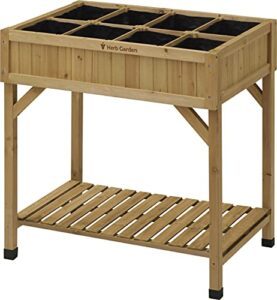
Standing tall at 80cm, this raised planter transforms your herb-growing game from backbreaking to back-friendly gardening.
You’ll love the eight separate pockets that keep your herbs organized while the pre-formed liner maintains healthy soil conditions.
Made from durable cedar wood with weather-resistant properties, it assembles quickly in just 15-20 minutes.
The bottom shelf provides handy storage for tools, making this planter both functional and attractive for patios or balconies.
Best For: Herb gardeners with limited mobility, small spaces, or anyone wanting organized, back-friendly cultivation without bending or kneeling.
- Ergonomic 80cm height eliminates back strain during planting, watering, and harvesting
- Eight separate pockets keep herbs organized and prevent root overcrowding
- Quick 15-20 minute assembly with pre-drilled holes and included hardware
- Long-term weather durability remains uncertain despite weather-resistant treatment
- Some splintering observed on wood surfaces, though doesn’t affect functionality
- Heavy weight when fully loaded with soil makes relocation difficult
10. Cole Mason Burwell Herb Keeper Triple

The Cole Mason Burwell keeps your herbs fresh with its smart self-watering system.
You’ll get up to 10 days longer freshness from your grocery store herbs without replanting them.
The hydro felt pads deliver consistent moisture while the covered design prevents evaporation.
This compact unit holds three potted herbs and fits perfectly on countertops or in refrigerator doors.
At around $25-30, it’s a practical investment that reduces herb waste by 30-50% compared to plastic storage methods, providing a significant reduction in waste with its self-watering system.
Best For: Home cooks who frequently use fresh herbs and want to extend their shelf life without the commitment of maintaining a full herb garden.
- Requires replacement hydro felt pads every 6-9 months with regular use
- Not suitable for long-term plant growth or serious gardening needs
- Some users report rusting issues with the spout over extended use
- Self-watering system extends herb freshness up to 10 days longer than traditional storage methods
- Compact design holds three potted herbs and fits easily on countertops or in refrigerator doors
- Reduces herb waste by 30-50% compared to plastic storage, making it cost-effective over time
11. LEETOLLA 32 Inch Rolling Garden Bed
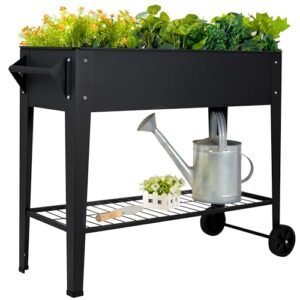
When you’re dealing with back pain or mobility issues, this rolling garden bed becomes your gardening game-changer.
It is built from powder-coated steel with triple-thick anti-rust coating, which supports up to 400 pounds while standing 32 inches tall to eliminate bending and kneeling.
The dual-layer drainage system with five holes and cross lines prevents waterlogging, while two universal wheels and an ergonomic handlebar let you chase the sun effortlessly.
Its 29.5-inch width fits tight spaces perfectly.
Best For: Gardeners with mobility issues, back pain, or limited space who want an ergonomic, durable raised bed that can be easily moved to optimize growing conditions.
- 32-inch height eliminates bending and kneeling, while wheels and handlebar make repositioning effortless even when loaded with soil
- Triple-thick anti-rust coating and 400-pound weight capacity provide exceptional durability with lifetime warranty coverage
- Dual-layer drainage system prevents waterlogging and root rot, promoting healthier plant growth
- Some users report minor water leakage from sides, though this can provide additional drainage benefits
- Limited to 29.5-inch width, which may restrict planting options for larger vegetables or multiple plant varieties
- Steel construction may retain heat in direct sunlight, potentially affecting soil temperature and plant comfort
12. Mr Stacky 5 Tier Planter
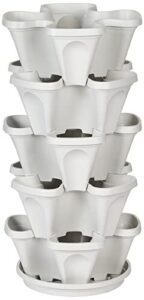
Maximizing your growing potential becomes effortless with the Mr Stacky 5 Tier Planter, offering 20 planting locations in just one square foot of space.
This innovative vertical garden features a patented flow-through design that waters all five tiers from the top, making maintenance incredibly simple for busy gardeners.
You’ll appreciate the food-safe polypropylene construction and built-in water reservoirs that prevent over-watering while ensuring consistent moisture distribution.
Perfect for herbs, strawberries, or flowers, this lightweight yet sturdy planter transforms any small space into a productive garden.
Best For: Apartment dwellers and gardeners with limited space who want to grow multiple plants vertically while maintaining easy watering and maintenance.
- Bottom tiers may dry out faster and require careful monitoring of water distribution
- Lightweight construction may need anchoring in windy outdoor conditions
- Limited space for plants with spreading growth habits like strawberry runners
- Space-efficient design provides 20 planting locations in just one square foot of floor space
- Patented flow-through watering system allows you to water all five tiers from the top only
- Made from durable, food-safe polypropylene that’s lightweight yet sturdy for both indoor and outdoor use
13. Keter Urban Bloomer Raised Garden

The Keter Urban Bloomer transforms your gardening experience with its elevated design that eliminates back strain while tending herbs.
You’ll appreciate the 12.7-gallon soil capacity that supports multiple herb varieties in its compact 32.3" x 14.7" footprint.
The built-in water gauge takes guesswork out of watering, while the drainage system prevents root rot.
Its UV-protected resin construction won’t fade or rust, and assembly requires just minutes with basic tools for immediate herb gardening success.
Best For: Urban gardeners with limited outdoor space who want an ergonomic, maintenance-free solution for growing herbs and vegetables without bending or kneeling.
- Water gauge functionality receives mixed reviews from users, with some reporting inaccuracy in moisture readings
- Assembly instructions lack clarity according to some customers, though most complete setup in 5-10 minutes
- Limited 12.7-gallon soil capacity may restrict growing larger vegetables or extensive herb collections
- Elevated 30.7" height eliminates back strain and makes gardening accessible for all ages and mobility levels
- Self-watering system with built-in gauge and drainage prevents overwatering while maintaining optimal soil moisture
- Weather-resistant UV-protected resin construction requires zero maintenance and won’t fade, rust, or deteriorate
14. VIVOSUN Self Watering Herb Planter Box
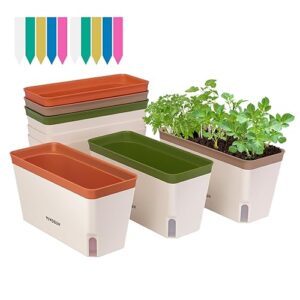
When you’re tired of daily watering routines, the VIVOSUN Self Watering Herb Planter Box becomes your gardening game-changer.
Its two-layer system with water-absorbent strips maintains perfect soil moisture for 3-10 days, preventing both drought stress and root rot.
The 10.5" × 4.5" × 5.5" compact design fits snugly on windowsills while the clear water level window lets you monitor hydration at a glance.
You’ll appreciate the included plant labels and BPA-free construction that keeps your herbs safe for consumption.
Best For: Beginners and busy gardeners who want a low-maintenance solution for growing herbs indoors with minimal daily watering effort.
- Shallow depth may limit growth of mature plants and expose roots over time
- Self-watering system can potentially cause root rot if moisture levels aren’t monitored
- Smaller actual dimensions than described may restrict plant development space
- Self-watering system maintains optimal moisture for 3-10 days, reducing daily maintenance
- Compact windowsill-friendly design with clear water level monitoring window
- BPA-free construction safe for growing edible herbs with included plant labels
15. Herb Garden Planter Indoor Set
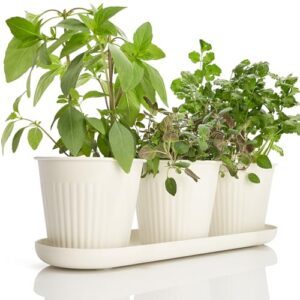
This compact farmhouse-style set brings fresh herbs within arm’s reach of your kitchen adventures.
You’ll get three cream-colored galvanized steel pots with a matching tray, perfect for countertops or windowsills.
The 4.1-inch pots feature drainage holes to prevent root rot, while rubber feet protect your surfaces.
Though better suited for small herbs or succulents rather than supermarket-sized plants, this powder-coated set offers rust resistance and no-assembly convenience for beginner gardeners seeking affordable indoor freshness.
Best For: Beginners seeking a decorative, low-maintenance solution for growing small herbs, succulents, or starter plants on kitchen counters or windowsills.
- Durable powder-coated galvanized steel construction with rust resistance and built-in drainage holes
- Compact farmhouse design fits most spaces with protective rubber feet and matching water-catching tray
- Ready-to-use convenience with no assembly required and easy portability for light adjustments
- Small 4.1-inch pot size limits growth potential for larger herbs or supermarket-sized plants
- Requires frequent watering due to limited soil capacity and drainage design
- Some users report rust concerns over time despite rust-resistant coating claims
Herb Planter Features and Styles
When selecting herb planters, you’ll find innovative features that make growing easier and more successful than traditional pots.
Modern designs incorporate sub-irrigation systems, stackable configurations, and weather-resistant materials that adapt to your specific growing conditions.
Sub-Irrigation Systems for Consistent Hydration
Sub-irrigation systems revolutionize herb garden maintenance by delivering water directly to plant roots through capillary action.
These self-watering designs reduce watering frequency by up to 70% while preventing overwatering and root rot. Advanced wick material choice and water reservoir size guarantee consistent moisture control for ideal herb garden maintenance.
Sub-irrigation helps maintain consistent soil moisture which reduces plant stress.
- Water Reservoir Size: Larger reservoirs sustain plants for 12+ weeks between refills, reducing maintenance while supporting deep root development
- Wick Material Choice: Quality wicking materials create efficient nutrient delivery methods through consistent capillary action from reservoir to root zone
- Root Aeration Balance: Well-draining soil combined with automation system integration prevents waterlogged conditions while maintaining ideal moisture levels
Vertical and Stackable Designs for Space Efficiency
When maximizing vertical space becomes your priority, stackable herb pots transform cramped areas into productive gardens.
These spacesaving solutions stack multiple growing levels, perfect for balcony herb garden setups where horizontal space is limited.
| Feature | Traditional Planters | Stackable Designs |
|---|---|---|
| Space Usage | Single level only | 3-5 growing tiers |
| Plant Capacity | 3-6 herbs maximum | 15-20 herbs possible |
| Footprint | Wide horizontal spread | Compact vertical tower |
DIY herb garden planter enthusiasts appreciate how these systems accommodate different herb selection needs while addressing stability concerns through interlocking bases and balanced weight distribution.
Consider browsing a retailer for various planter options.
Weather-Resistant Materials for Indoor and Outdoor Use
When choosing weather-resistant planters for your herb garden, you’ll want materials that handle nature’s curveballs without breaking a sweat.
The best indoor-outdoor planters offer superior material lifespan through advanced engineering:
- Fiberglass planters – Provide UV protection and temperature resistance while staying 70% lighter than concrete
- Stainless steel containers – Deliver exceptional moisture tolerance and frost proofing for durable outdoor herb garden use
- High-density resin materials – Maintain flexibility and resist cracking through extreme weather cycles
Consider ceramic container durability if you want something long-lasting.
Chalkboard Labels for Seed Identification
With your herb garden kit, chalkboard labels transform seed identification from guesswork into organization.
These weatherproof tags offer superior label durability compared to paper alternatives, withstanding moisture and UV exposure.
You’ll appreciate the chalk variety available—from traditional white to colorful options that enhance labeling aesthetics.
For erasing methods, simply wipe with damp cloth for fresh starts.
DIY chalkboards can be crafted from adhesive strips, making your herb planter box both functional and stylish.
Maintaining and Enjoying Herb Gardens
Once you’ve chosen the perfect herb planter, you’ll need to master the basics of care to keep your herbs thriving year-round.
Proper maintenance guarantees you’ll have fresh, flavorful herbs ready whenever you need them for cooking or natural remedies, ensuring proper care is essential for their growth.
Watering and Fertilization Tips
Most herbs thrive with watering frequency of 2-3 times weekly, but check soil moisture first.
Well-draining soil prevents overwatering signs like yellowing leaves or root rot.
Use balanced, diluted fertilizer monthly during growing season.
Nutrient-enriched soil reduces fertilizer needs.
Monitor soil pH between 6.0-7.0 for ideal nutrient absorption and healthy herb gardening tips success.
Pruning and Repotting for Healthy Growth
Regular pruning transforms your herb garden from struggling seedlings into productive powerhouses.
Strategic cuts encourage bushier growth while preventing herbs from becoming leggy or going to seed prematurely.
Essential herb maintenance practices:
- Pruning Techniques – Pinch flowers before they bloom to maintain leaf flavor, and harvest outer leaves first to promote continuous growth
- Repotting Frequency – Move herbs to larger containers every 12-18 months when roots circle the pot’s bottom
- Root Trimming – Trim circling roots during repotting and refresh with new potting mix for maximum nutrient absorption
To maintain soil health, consider organic matter application.
Companion Planting for Optimal Flavor and Nutrition
Smart companion planting transforms your herb garden into a powerhouse of flavor enhancement and nutritional value.
Transform your kitchen into an aromatic sanctuary where fresh herbs are always within reach.
Strategic herb combinations create natural pest control while maximizing growth support through nutrient synergy.
These companion planting techniques optimize space and boost your garden’s overall productivity.
| Herb Pairings | Benefits |
|---|---|
| Basil + Tomatoes | Enhanced sweetness, improved flavor compounds |
| Thyme + Oregano + Sage | Shared growing conditions, stronger aromatics |
| Chamomile + Mint + Parsley | Amplified essential oil production |
| Dill + Cilantro + Beans | Nitrogen fixation, increased herb growth |
Frequently Asked Questions (FAQs)
What planters are best for herbs?
Like choosing the perfect dance partner, you’ll want cedar, stainless steel, or terra cotta planters with drainage holes. They’re durable, food-safe, and let your herbs’ roots breathe properly.
What herbs not to plant together in pots?
Don’t plant mint with other herbs—it’ll take over aggressively. Keep Mediterranean herbs like rosemary separate from moisture-loving ones like basil, as they need different watering schedules.
Do herbs like deep or shallow pots?
Absolutely crushing your herb dreams with shallow pots won’t work!
You’ll need deeper containers since most herbs develop surprisingly extensive root systems.
Choose pots that’re 6-12 inches deep for healthy growth and vigorous harvests.
What is the best layout for an herb garden?
Group herbs by growing needs: Mediterranean herbs (rosemary, thyme, oregano) together in sunny, well-draining spots; moisture-loving herbs (basil, parsley, cilantro) in shadier areas. Keep mint isolated to prevent aggressive spreading.
How do you create a successful herb garden planter?
Your herb garden’s success blooms from choosing the right vessel and soil recipe.
Select well-draining planters with 6-inch depth, use quality potting mix, match herbs by water needs, and guarantee six hours of daily sunlight.
What are the best materials to use for an herb garden planter?
Choose cedar, stainless steel, or terra cotta for food-safe, durable options. Plastic retains moisture well but degrades outdoors. Make certain proper drainage holes prevent root rot and promote healthy growth.
Are herb garden planters suitable for outdoor use?
Yes, most herb garden planters work perfectly outdoors. Weather-resistant materials like cedar, stainless steel, and terra cotta handle temperature changes well, while proper drainage prevents waterlogging during rainy seasons.
What are some of the most popular herbs to grow in planters?
Like a chef’s knife collection, you’ll want basil, cilantro, chives, parsley, oregano, rosemary, sage, thyme, mint, and marjoram for versatile cooking adventures in containers.
What herbs go well together in a container?
Mediterranean herbs like thyme, oregano, and sage thrive together in dry conditions.
While basil, parsley, and chives prefer moist, sunny spots.
Group herbs by water and light needs for success, keeping mint isolated to prevent spreading.
Do herbs need a deep planter?
Think of roots as your herbs’ foundation – they need room to spread their wings.
Most herbs thrive in planters 6-12 inches deep, giving their root systems adequate space to develop and access nutrients for healthy growth.
Conclusion
Whether you’re growing basil on your windowsill or cultivating rosemary on your patio, the right herb garden planters make all the difference.
You’ll save money while enjoying fresher flavors, and you’ll transform any space into a productive garden.
From hydroponic systems to stackable designs, these planters offer convenience and efficiency.
Choose models with proper drainage, adequate capacity, and durable materials.
With consistent care and the perfect planter, you’ll harvest fresh herbs year-round and elevate every meal you prepare.

